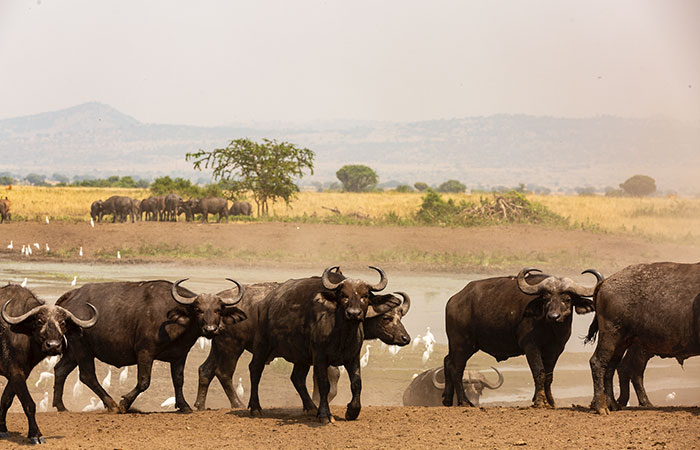Serengeti National Park is located in Tanzania and is part of the larger Serengeti ecosystem, which covers 12,000 square miles (30,000 sq km) and includes several other game reserves. The national park itself covers an area of 5,700 square miles (14,750 sq km). It runs contiguously with the Masai Mara of Kenya.
The name Serengeti is derived from a similar Masai word that translates to “the place where land runs on forever.” It is also affectionately known as the “endless plains.” The area is comprised of grassland plains, savanna, riverine forest, and woodlands. Although the majority of the park is open plains, the elevation does vary from 3,000 to 6,000 feet (914 to 1,828 m). The lofty rock croppings spawn visions of the movie “Lion King,” and it is possible you may even see lions on them.
The Serengeti, Ngorongoro Crater, and Mount Kilimanjaro are almost inseparable when it comes to traveling to Tanzania. Visitors will almost always experience three of these together. Ngorongoro Crater and the Serengeti share the migrating wildebeest, zebra, and impala herds.
In general, the park is often described as three regions with boundaries of the national park. The primary area is the Serengeti plains, where the wildebeest breed. A second area is a western corridor featuring black clay-covered savannahs. This area is home to crocodiles and hippopotamuses. The hippo pool located near this region is a guaranteed place to see hippos sleeping and wallowing around. The third area is the northern Serengeti, which is where the majority of hills and woodlands occur. This is the best place to find an elephant and a giraffe.
The Serengeti National Park is globally renowned for its abundance and variety of wildlife as well as high biodiversity. The Big 5 (lion, leopard, elephant, rhino, and buffalo) can all be experienced in the park. Except for the mountain gorillas, all of Africa’s Big 7 (lion, leopard, elephant, rhino, hippo, and crocodile) can be found in the national park.
Predators beyond the lion and leopard include the cheetah, hyena, jackal, African golden wolf, honey badger, serval, and African wild dog. Because the park landscape is so open, there is a fair chance that you will see most of the predator species. Keep your eyes open for gathered safari vehicles; you can almost guarantee if there are more than three gathered together, they are looking at a lion or leopard.
The largest remaining unaltered mammalian migration in the world is the pinnacle wildlife experience of the Serengeti. The migration features over 1.3 million wildebeest, 250,000 zebra, 500,000 gazelles, and tens of thousands of topi, hartebeest, and impala. This statistic is one of the main reasons the migration was selected as one of the Seven Natural Wonders of Africa.
WHAT TO KNOW ABOUT SERENGETI NATIONAL PARK
The Serengeti National Park is one of the most coveted safari destinations in the world. There is no question of “if” you will see anything but rather how many of which ones. Speaking of the Big 5, there are approximately 3,000 lions, 1,000 leopards, and 5,000 elephants. The most abundant is the buffalo, with approximately 53,000 of them. Unfortunately, there are only 31 individual rhinoceroses left in the park because of poaching.
The expanse of the Serengeti National Park creates the opportunity for endless roaming as safari-goers pursue their ultimate wildlife encounters. Ballooning over the plains is stunning; however, it is awe-inspiring to balloon over the migration herd to actually get a panoramic view of its enormity.
One of the most exciting natural facts of the migration occurs in September or October when the migrating herd of wildebeest, zebra, and other ungulates cross the Mara River into Kenya and the Masai Mara Game Reserve. Watching hundreds of wildebeest cross the river at any given moment is a spectacular sight. It will also leave you speechless if you witness one of the crocodiles in the river capture one of the members of the cross herd.

